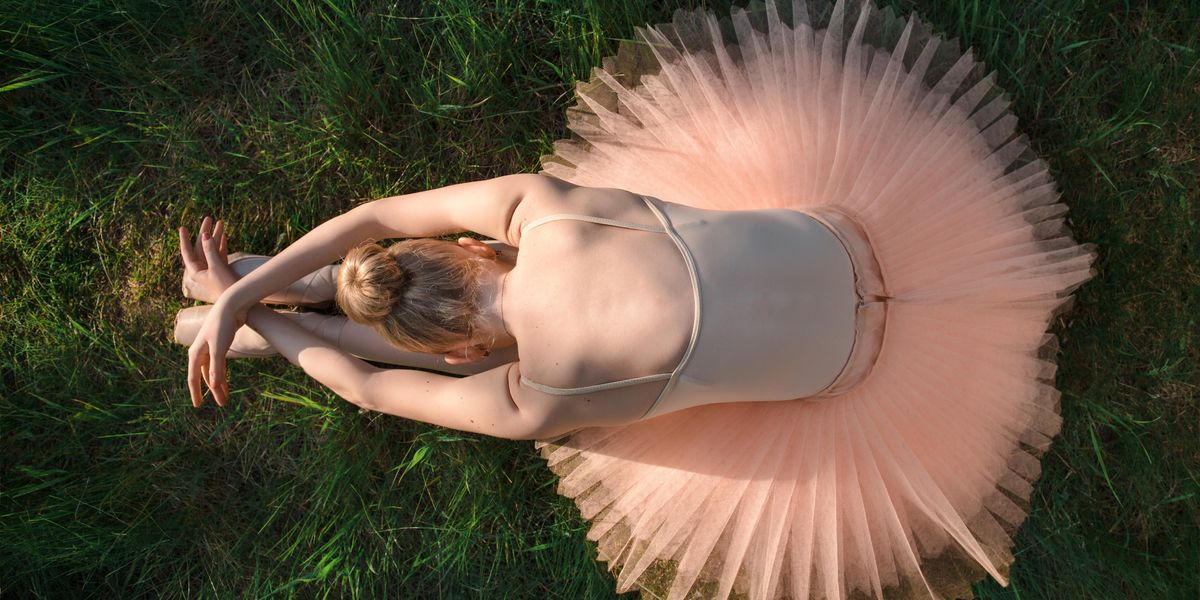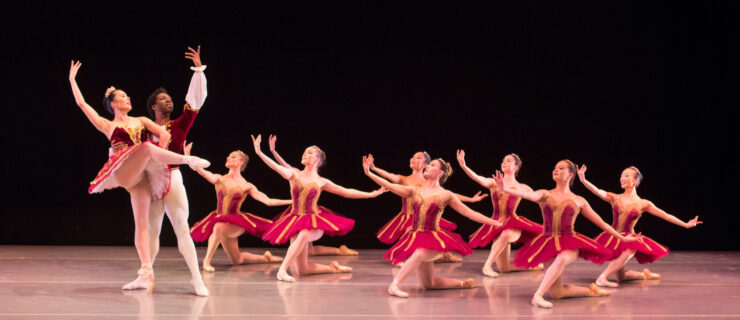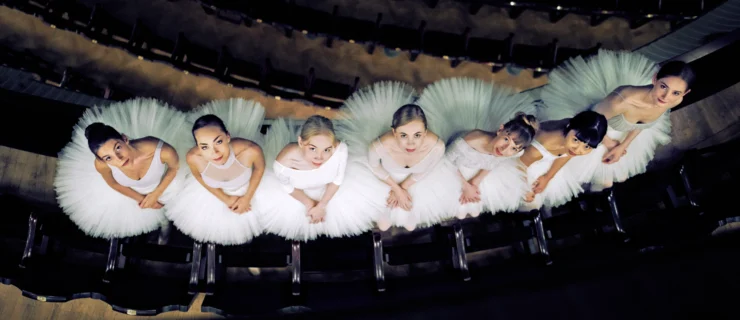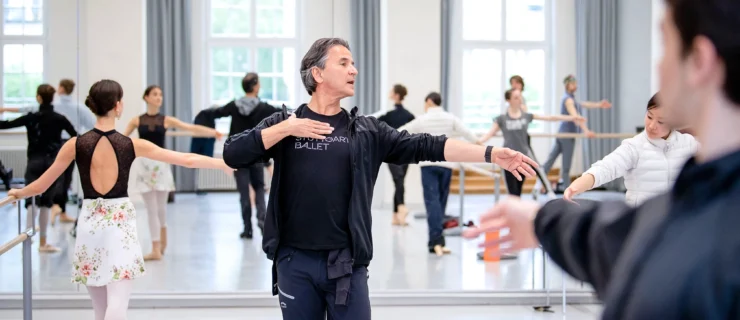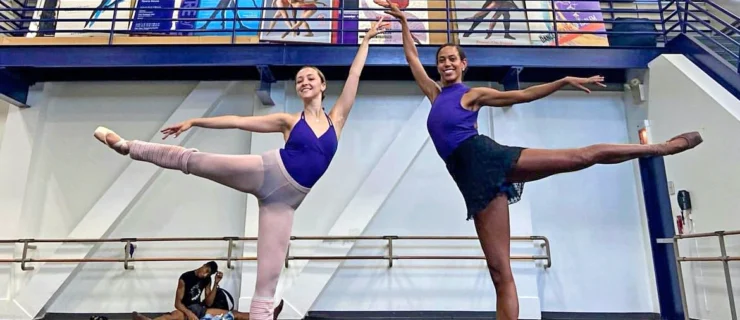Death Becomes Her
As I stood in Joyce SoHo’s rehearsal studio in New York clad in a black robe, cape, skull mask and six-inch platform boots, I tried desperately to steady myself in a wide second position as 12 “ghouls” crawled through my legs. Fighting with the trappings of my outfit, I was teetering like a newborn colt—and swathed in fabric with my vision impaired. We were in rehearsal for Donald Byrd’s production of The Harlem Nutcracker and I had been cast as Death, whose job it is to beckon Grandmother Clara to her grave. It wasn’t exactly the principal role I had in mind, especially given the costume.
The boots alone were a death trap. When one of the ghouls got entangled in my cape and sent us both toppling to the floor, I had to wonder, “Was this going to become method acting?” I quickly realized that learning how to fall without twisting an ankle was the first order of business.
Through trial and much error, I eventually discovered the secret to staying upright—swooshing the cape to clear a path before moving my feet. A bonus was that my strategy created the grandeur the character demanded. I also found that breathing through my mouth behind a mask amounted to a steam facial.
But while I learned to negotiate my cape, my ego was still ensnared. Though pivotal to the plot, Death is not the sexiest of roles. “What prompted the casting?” I wondered. Previously, Death had always been played by a man. Yet I had to get beyond myself to figure out how to make this character come to life. At a point I realized that it wasn’t the role I resented but the costume. If I could have been Death in a couture dress, I would have been all about it!
I started to contemplate all the time I’d spent perfecting my technique at the barre. All the years of pointe shoes and pain had come down to this: murder! Yet early on there had been clues that a career in ballet wasn’t all tulle and tiaras.
As a tall 10-year-old, I was cast as a Polichinelle boy in Pennsylvania Ballet’s Nutcracker. Rehearsing along with three other prepubescent girls in the studio, we learned to squat-walk sideways as though we were under Mother Ginger’s immense hoop skirt. But nothing quite prepared us for the actual experience. When fully costumed (including a Napoleon-style hat), the true dimensions of the heat-trapping skirt proved unexpectedly unnerving. Having to run back under the skirt onstage and get in sync for the exit was traumatizing—there was always a fear of someone not making it or falling over under the skirt. And you know the credo: “Leave no Polichinelle behind!”
I was brought back to my Death rehearsal reality when one of my ghoul spawn in hot pursuit of his prey trampled on my cape. Fortunately, we were soon breaking for 15. Seizing the opportunity to remove my mask and shed my robes, I went to the restroom. As I peered into the mirror, my mind traveled back to high school when for a brief time I performed with a traveling circus. We danced between acts and closed each night with a Vegas-style showgirl number. Choreographically, step-touch-pivot-perch was simple, but the costumes proved spatially challenging. The black sequined headpiece reminded me of Tina Turner’s headdress in Mad Max Beyond Thunderdome, only mine exploded in bright yellow plumage. The five-pronged plume that made up my tail was attached to sequin piped trunks. I had never been less self-conscious about my behind, but navigating cramped backstage areas with my Big Bird–like mane and tail was not easy, nor was taking a feather in the eye from another member of the flock.
However, the Universe is all knowing, as this was clearly preparation for my role as a Firebird Maiden with Dance Theatre of Harlem, where an ill-timed tilt of the head could result in Miss Universe–like crowns hooking together, sometimes causing the linked maidens to exit the stage like royal Siamese twins. Once, seconds before an entrance, I got linked to someone else’s headpiece. Luckily a flurry of fellow dancers descended from all sides with nimble fingers to set us free in the nick of time.
As I returned to the studio, I started thinking: Maybe there was a method to the madness of the crazy recital costumes of our youth. The bunny ears, cat noses, the flapper feathers left strewn center stage in the wake of a crowd-pleasing tap number were a necessary part of our training. It was all in preparation for…Death. The great irony is that as children we could laugh at ourselves. As adult dancers, we tend to take ourselves too seriously, using levels of angst as a barometer for passion.
While the role of Death was not the most physically demanding, it afforded me great insight. I learned that when faced with cumbersome accoutrements, your attitude can be your biggest asset—or impediment—to mastering a role. An ability to laugh at yourself in the process might be the key to alleviating frustration and finding the solution. Honestly, who trains to pirouette while wearing a headdress? Most choreographers don’t expect you to execute with perfection immediately; that is precisely what rehearsals are for. What is called upon is the skill of solving movement problems with ingenuity and professionalism; that is something you are trained for. Sometimes the measure of your artistry has less to do with technique and more with how open you are to new experiences, and a desire to investigate the possibilities.
When rehearsal resumed, we moved into Act II, which is set in a nightclub. Now, as the sassy Cigarette Girl and Sugar Rum Cherry, I was briefly freed from my layers to don heels and a sequined red dress. Instantly my mood improved; there is something about pumps and sequins that can brighten a gal’s disposition. Yet it would be short-lived, as I would be back in my murderous togs later to finish Grandmother Clara off, albeit the audience had no idea that beneath her mask, Death was wearing lipgloss.
Theresa Ruth Howard is a faculty member at The Ailey School and also a contributing writer for
Dance Magazine.
